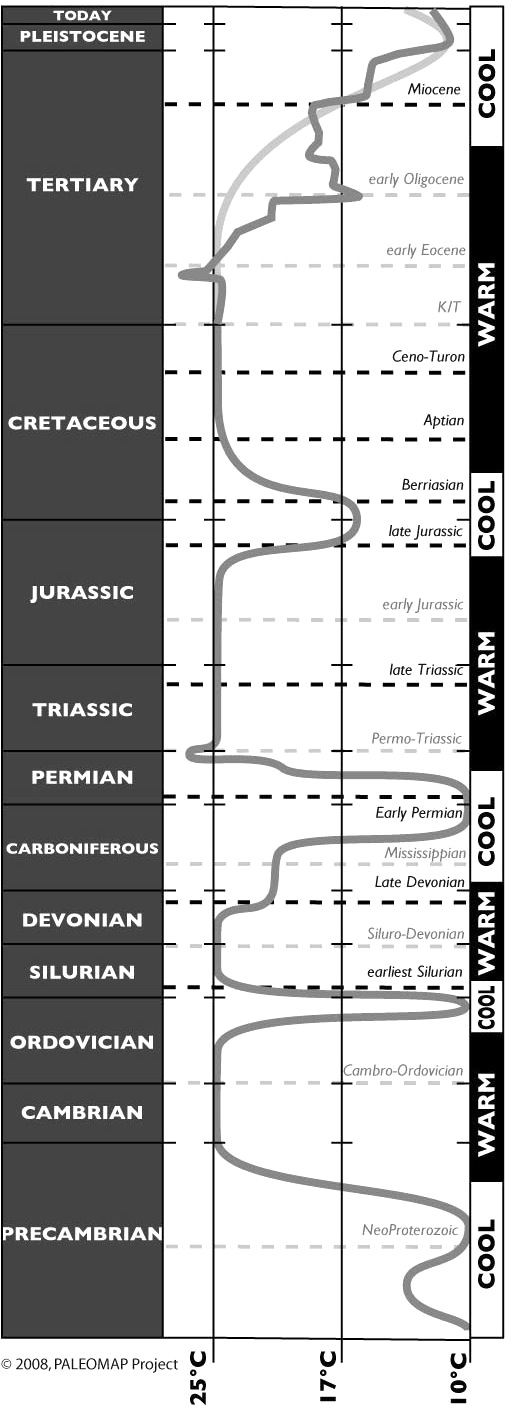
warm hothouse phases to cold icehouse
phases (PALEOMAP Project, 2008).
Throughout the Earth’s vast history, the planet has undergone many glacial phases. These phases affect the extent of snow cover at all latitudes. Over the last 500 million years, multiple “icehouse” climates and interglacial warm periods have occurred (Figure 1). These periods of change alter the planet’s snow cover from extending close to the equator, to no snow at all. More recently, during the last glacial maximum period 18,000 years before present, perennial snow coverage extending into southern United States. This glacial age was part of the Quaternary period, a time with episodic glacial cycles lasting two million years in the Northern Hemisphere (Figure 2). The glacial cycles occurred as glacial advances and interglacial retreats, occurring on approximate 100,000-year time intervals. For the past 10,000 years, the Earth has been in a state of interglacial retreat. The 100,000-year time intervals correlate with solar radiation variation, due to Earth’s orbit and axial properties called Milankovitch Cycles. These Milankovitch Cycles cause slow variations in the seasonal distribution of radiation across the planet, as well as climate system feedbacks involving snow/ice albedo, atmospheric water vapour, and carbon dioxide (CO2). During times of higher solar radiation, the Earth transforms into a warm, humid interglacial and during times of lower solar radiation, a cold, dry glacial state prevails. Generally, the alteration from a global state of glacial to interglacial occurs at a faster rate than interglacial to glacial state. This transpires because as glacial ice warms and melts, a positive feedback commences, melting ice at a faster rate. Additionally, as this glacial ice melts, carbon dioxide trapped within air bubbles are released – contributing to a warmer atmospheric temperature (NOAA, 2008).

The last glacial period in Canada peaked about 21,000 years ago, at which time almost all of Canada was covered by ice. Ice retreated slowly at first, with the ice sheets still present in the northern United States 14,500 years ago. They began to thin and retreat dramatically over the next several thousand years, until ice finally cleared out of Hudson Bay about 8,000 years ago. North America's Laurentide Ice Sheet was the largest of the ice sheets, exceeding even present-day Antarctica in ice volume, so it drove the timing and pace of the global-scale deglaciation.
Summer sunshine in the far north was quite strong during the last deglaciation (the early Holocene), which appears to have driven an "overshoot" of ice retreat coming out of the last glaciation. Most mid-latitude glaciers in the northern hemisphere melted back or disappeared during in the early to mid-Holocene, around 6,000 years ago, including the Columbia Icefields in the Canadian Rockies. Ice cores in Greenland and the Canadian high Arctic indicate that there was substantial summer melt at this time, exceeding the average summer melt totals of the 20th century. Despite this, fragments of the North American ice sheet actually survived until present day in the Canadian Arctic, including the Penny and Barnes Ice Caps on Baffin Island and several of the larger icefields on Devon and Ellesmere Islands. Very old Pleistocene ice is found in the lower section of these ice caps.
Mountain glaciers and polar icefields re-advanced as summer sunshine weakened in northern latitudes over the last several thousand years. The moraine (glacial rock deposits) record indicates several sequences of glacier advance and retreat, culminating in the Little Ice Age advance between the years 1600 and 1900. Many northern hemisphere glaciers reached their maximum recent extent during this period (e.g. Solomina et al., 2008; Ivy-Ochs et al., 2009) before a relatively dramatic, worldwide retreat of glaciers began in the late 1800s. In many places, such as western Canada, Alaska, and Patagonia in southern South America, lake sediments and tree fragments that have emerged from glacier retreat indicate that some mountain glaciers have retreated past anything seen in more than 3,000 years. Arctic ice caps are also responding to recent climate warming, although sometimes more subtly because the available solar energy for melting in the high Arctic is limited.
References
Glacier Links
Material on this page was provided by Professor Shawn Marshall (Canada Research Chair in Climate Change, Department of Geography, University of Calgary, Alberta) and Maren Pauly (Department of Geography, University of Waterloo).
